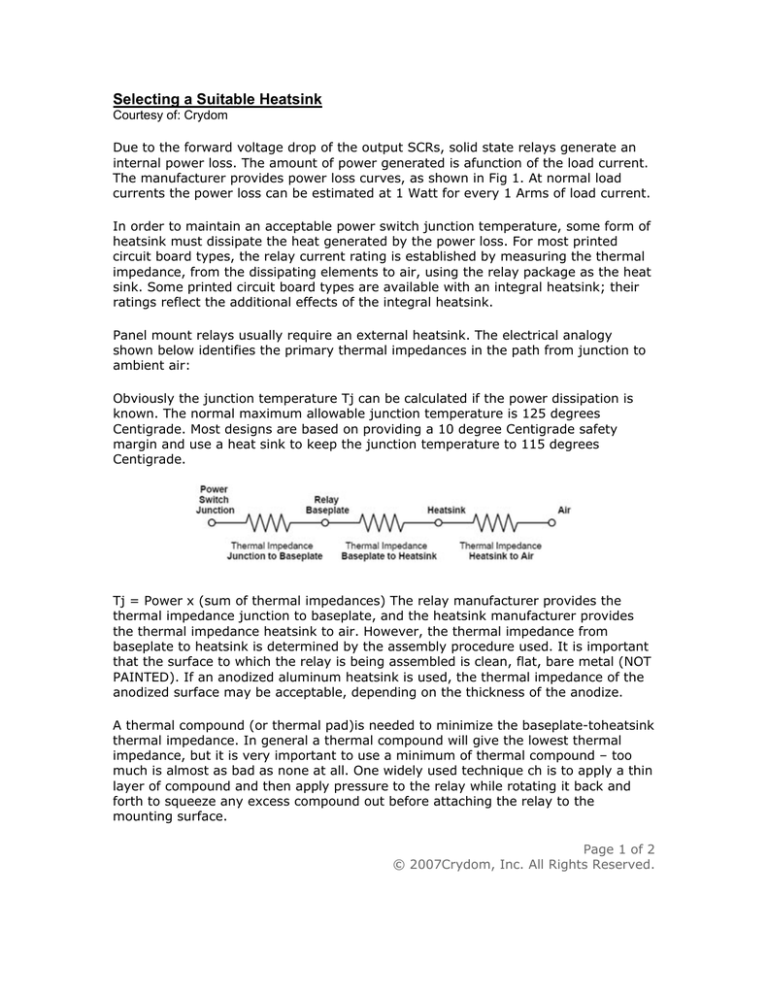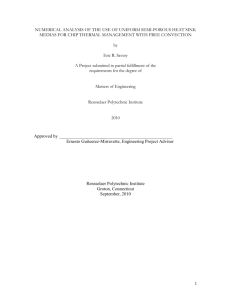
Selecting a Suitable Heatsink
Courtesy of: Crydom
Due to the forward voltage drop of the output SCRs, solid state relays generate an
internal power loss. The amount of power generated is afunction of the load current.
The manufacturer provides power loss curves, as shown in Fig 1. At normal load
currents the power loss can be estimated at 1 Watt for every 1 Arms of load current.
In order to maintain an acceptable power switch junction temperature, some form of
heatsink must dissipate the heat generated by the power loss. For most printed
circuit board types, the relay current rating is established by measuring the thermal
impedance, from the dissipating elements to air, using the relay package as the heat
sink. Some printed circuit board types are available with an integral heatsink; their
ratings reflect the additional effects of the integral heatsink.
Panel mount relays usually require an external heatsink. The electrical analogy
shown below identifies the primary thermal impedances in the path from junction to
ambient air:
Obviously the junction temperature Tj can be calculated if the power dissipation is
known. The normal maximum allowable junction temperature is 125 degrees
Centigrade. Most designs are based on providing a 10 degree Centigrade safety
margin and use a heat sink to keep the junction temperature to 115 degrees
Centigrade.
Tj = Power x (sum of thermal impedances) The relay manufacturer provides the
thermal impedance junction to baseplate, and the heatsink manufacturer provides
the thermal impedance heatsink to air. However, the thermal impedance from
baseplate to heatsink is determined by the assembly procedure used. It is important
that the surface to which the relay is being assembled is clean, flat, bare metal (NOT
PAINTED). If an anodized aluminum heatsink is used, the thermal impedance of the
anodized surface may be acceptable, depending on the thickness of the anodize.
A thermal compound (or thermal pad)is needed to minimize the baseplate-toheatsink
thermal impedance. In general a thermal compound will give the lowest thermal
impedance, but it is very important to use a minimum of thermal compound – too
much is almost as bad as none at all. One widely used technique ch is to apply a thin
layer of compound and then apply pressure to the relay while rotating it back and
forth to squeeze any excess compound out before attaching the relay to the
mounting surface.
Page 1 of 2
© 2007Crydom, Inc. All Rights Reserved.
In some applications the relay will be mounted directly to a panel. This technique will
work up to load currents of 7 to 8 Arms depending on the panel material, ambient
temperature, etc. In these cases it is absolutely essential to mount the relay to an un
painted surface and use a good thermal compound. As a rule, the minimum perrelay
panel area should be 25 square inches.
Above these current levels some form of heatsink will be required. Determine
heatsink thermal impedance using rating curves like those shown in Fig 1.
The figure shown is for a 50 Arms rated relay. Assume the load current is 30Arms,
then in the left hand side of the curve the power dissipated is seen to be 31 Watts.
Reading across to the heatsink versus ambient temperature curves shows that an
ambient of 40 degrees Centigrade requires a heatsink with a thermal impedance of 2
degrees Centigrade per Watt. However, toreduce the junction temperature to
approximately 115 degrees Centigrade, a heatsink of about 1.5 degrees Centigrade
would be more suitable. If the point of 31 Watts dissipation is read all the way to the
right, then them aximum allowable baseplate temperature is shown for a junction
temperature of 125 degrees Centigrade. In the example discussed, this is 106
degrees Centigrade. However, to allow for the 10 degrees Centigrade safety factor,
the baseplate temperature should not exceed 96 degrees Centigrade.
As shown by the thermal impedance curves for HS-1 and HS-2 heat sinks in Fig 2,
not only is the surface area of the heatsink a factor but also the power being
dissipated. There are many sources for heat sinks, enabling designers to select one
most suitable thermally and mechanically for the application.
How to verify the proper Heat Sink
In certain instances, once the heat sink requirements for a SSR in a particular
application have been determined and installed, it may be desirable to verify that the
system does indeed provide adequate cooling to ensure reliable SSR operation.
The following is a relatively simple method to check this suitability, and essentially
uses some of the calculations from SELECTING A SUITABLE HEAT SINK (above) in a
reverse manner. This technique may also be used on existing systems in the field
that might have been more or less “empirically” designed, to gain information on
their performance and potential reliabilty. This method involves determining the
temperature of the internal power devices, (SCR’s or Triac), within the SSR and then
comparing that temperature with a “standard” absolute maximum temperature that
the SSR power devices must never exceed. The maxium power device temperature is
generally considered to be 125°C but for an added safety margin, 115°C should be
used. (Of course for the truest indication, the entire system being evaluated should
be stable and operating at its maximum rated parameters including load currents,
ambient temperatures, and with doors and access panels in their normal o perating
positions.)
There are three additional pieces of data needed to perform this evaluation. They are
the actual load current switched by the SSR, the specified “Thermal Resistance –
Junction to Case” - Rθjc of the SSR, and the measured temperature of the SSR base
plate. Ideally, the temperature measurement of the SSR base plate should be taken
directly from the bottom center of the SSR. However, since in most installations this
is not practical since the SSR is mounted to a heat sink surface, the next best
accessible location is on the top surface of the base plate near the mounting screw
holes at the junction of the plastic case to the base plate surface. (To compensate for
this measurement location, it is a good practice to add 3 to 5 degrees to the actual
measurement.)
Using the above data, and an estimated power drop of 1 Watt for every 1 Arms of
load current, the total internal dissipation in Watts can be calculated. (e.g. 35 Arms
load = 35 Watts of internal dissipation.) Next, multiply the internal dissipation in
Watts by the Rθjc value, (in °C/W), to determine the internal temperature rise. This
temperature value is added to the measured base plate temperature to arrive at the
calculated temperature of the internal power devices. If this value is less than the
115°C “standard maximum with safety margin” value, then the heat sink is
adequate.
In some cases, the heat sink information and derate curves provided within the SSR
specification sheets may include expected base plate temperatures, but generally do
not consider the safety margin values.





